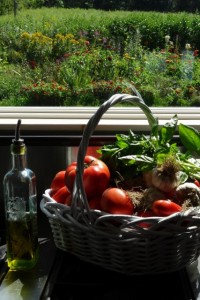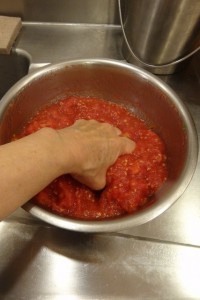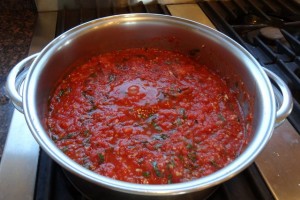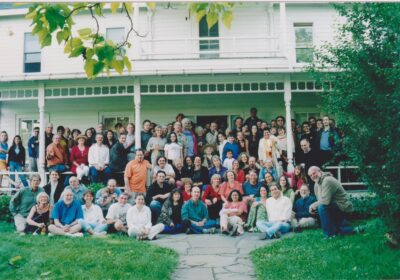Better Than Your Grandma’s Marinara


When my husband Vic and I got serious about healthy eating in 1967, his mom Virginia gave me a copy of Let’s Cook It Right by Adele Davis. Vic was not thrilled with bran molasses cookies and kidney stew. By 1971, Vic, our baby David, and I were vegetarians. I bought Diet for a Small Planet by Frances Moore Lappé and baked leaden nut loaves. Few of my creations made our mouths water, so we visited the Cornell University Hotel School Library and borrowed cookbooks. I tried Japanese, Thai, Ethiopian, and Indian, but when I cooked Italian, I scored. Vic loved food that reminded him of his Italian grandma’s garden creations, the food he had loved as a child, so I couldn’t go wrong if I started with olive oil and garlic. Swiss chard and fresh onions, zucchini and escarole, and garlicky green beans made him smile, but he especially liked pasta with marinara sauce.
Virginia taught me how to make marinara sauce the way her mother made it. I simmered peeled and mashed tomatoes many hours to boil away the moisture before adding onions and garlic sautéed in olive oil, salt, pepper, oregano, and basil.
In 1996 on a vacation in Costa Rico, Vic and I found a modest Italian restaurant overlooking the Pacific Ocean. The barely cooked tomato sauce was vibrant red with flecks of bright green. The restaurant owner, a haughty Italian woman who wore spike heels with her white chef’s apron, reluctantly gave me a vague recipe. When I got home, I did the unthinkable. I created a marinara sauce that Vic liked better than his grandma’s sauce. I offer it to you.
16 cups peeled Italian paste tomatoes mashed with your hands or a potato masher. Put the lumpy mush in a stainless steel colander (I use a large stainless pot with a vegetable steamer or colander insert) and let drain until the tomatoes lose half their volume. Timing depends on the moisture content of the tomatoes, but I begin first thing in the morning and let the tomatoes drain all day or begin after dinner and let them drain in the refrigerator overnight. Gently use a spatula to pull tomato mush away from the colander sides a few times to free the holes of seeds and hasten draining.
Then, sauté 10 cloves thinly sliced or diced fresh garlic (more or less) in 1/3 cup extra virgin olive oil.
When the garlic is lightly browned, add 1 tsp salt, ½ tsp black pepper, and ¼ tsp cayenne pepper (optional).

Add drained tomatoes and heat to a low simmer. Finally, add ½ cup (or more) of finely chopped basil, let the leaves wilt, and serve when the tomatoes are hot, but barely cooked. The taste is supreme and the sauce freezes well. I thaw a quart or two of frozen sauce on the darkest days of winter and serve over Christmas pasta. Here I show the sauce served over a black bean burger.
How do you make marinara sauce? Follow this link for more of my favorite recipes.



September 15, 2016 at 1:46 pm
Kim Kluxen Meredith
Thank you Elaine.
The Amish tomato crop is coming to an end so I better get going.
Pretty soon it will be my applesauce time.
Freezer space is my challenge.
I love to pull out my little canned gems on a cold January day and dream about a summer garden.
I will be thinking of you when my kitchen fills with a delightful garlic aroma!
Kim
September 15, 2016 at 2:57 pm
Elaine Mansfield
This recipe is great in small or large batches for fresh sauces. If I want to store it, I freeze since canning undoes the freshness of the basil/tomato flavors. Then again, everything is fine when it comes to cooking and I canned all my tomato sauce until I was given this recipe. I’m grateful my daughter-in-law shares her canned gems. My canning pot is in the cellar housing spiders with elaborate cobwebs. I won’t disturb them for now. Garlic is a favorite. I have 50 fat cloves in my cellar grown organically by a local friend. One more thing I’m happy to let someone else tend.
September 15, 2016 at 10:34 am
Marian Beaman
Thanks for this, Elaine. I’ve printed it out – now have to find fresh ingredients.
Interesting how blog posts keep serving 4 years later. I didn’t know you in 2012; in fact, I wasn’t even blogging then. 🙂
September 15, 2016 at 3:04 pm
Elaine Mansfield
This is one I may re-do and share again soon while people still have fresh tomatoes. I can add more photos and more stories. I rarely recycle my blogs, but most of my readers (and your readers in the same way) don’t know anything about those early posts. Some are favorites. Let’s think about bringing them back. I loved seeing your article in The Mennonite. Here’s to food and faith and the importance of shared symbolic and edible food at sacred occasions.
November 20, 2012 at 2:26 am
RitaMarie
Read your blog.
Was also married for over 40 years and it’s been 8 years since husband died. I was angry when he died aside from feeling heartbroken and lost. It took awhile to adjust to the this whole new existance. I don’t know that I ever will really. I didn’t cry when he died. I knew it was coming, I kept a stiff upper lip as they say. Eight years later I broke down crying. Finally! I’d had enough of that stiff upper lip routine. I did however learn to put one foot in front of the other and tackle one hurdle at a time and to take my time doing it. I changed my routines, I changed simple things like the layout of the house, the colors in my rooms, the dishes I ate off of, and so forth until I had remodled my new life to suit a different time clock all together. I think this helps!
I try to find something beautiful and something hilarious in each day and something important to read about or care about and I take the time to be kind to everyone I meet. This is also helpful to me as well. It comes back to me in many ways. I grew a garden, I made things live..I felt joy seeing them grow. I grew food and cooked with it and changed how and when I ate. I changed my hair. I loved him dearly, we met at kids, he was a good and loving man and father, I miss him so very much, but he would wish life and joy for me I know, and so I’ve set about doing this favor for us both. I finished some of the things we’d begun to our home, and moved on once that was completed. After all this time alone without him, but thinking of him almost a dozen times a day, I’ve met another person who is also alone and we’ve struck up a friendship that appears to be deeper than just an ordinary friendship and I am allowing this to happen on behalf of the life I have remaining. It is nice to know that “feeling” is okay and that life really does continue on..you can sit on the side and watch it or join in…I want to join in finally! 😉
November 20, 2012 at 7:10 am
Elaine Mansfield
Thank you, Rita Marie, for your full rich response. I resonate with so much of what you mention–the need to change the patterns of life and find new paths of pleasure, new ways to celebrate, new growth, new plants, new dogs (in my case), new loves. I’ve also needed to remember, record, and digest. For this, I write and talk to others. I experience some anger, although that isn’t primary for me, and I’m lousy at keeping a stiff upper lip. Bit by bit, I learn to carry my grief and tears along with me as new and surprising possibilities open up. We’ll see what happens next. If it works for you, stay in touch and let me know how you’re doing as it sounds like your life is full of beginnings and open doors. I wish you the best in life and love.
September 15, 2012 at 1:50 pm
Fred Weiner
mmmmmm yes. I still make variations on this, though I learned the base marinara recipe from Lenny through Vinny; more or less identical to yours. Even canned california organics do the job, but at the mention of San Marzanos, I remember some of Dotty’s gardens and start to get a little envious . . .
September 15, 2012 at 2:49 pm
Elaine Mansfield
I think you’d be forgiven for envying San Marzano’s. The canned ones don’t do it for me. They have to be fresh and nearly raw. Warm greetings to you, old friend.
September 12, 2012 at 4:08 pm
Joshua Weiner
Yum! I will have to try this.
September 12, 2012 at 3:46 pm
Joshua Weiner
Terrific article and recipe!
September 13, 2012 at 11:38 am
Elaine Mansfield
Thanks, Josh. When you lived in Hector some years back and I was making this marinara sauce, you said, “There can never be too much garlic in marinara sauce.” I’ve not been able to prove you wrong. And I’d add, never too much basil either. Good tomatoes here this year, especially the San Marzanos. Wishing you the best.